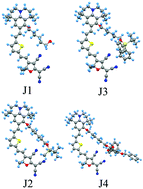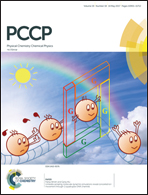Structural control of side-chain chromophores to achieve highly efficient electro-optic activity
Abstract
A series of chromophores J1–J4 have been synthesized based on julolidine donors modified with different rigid steric hindrance groups. Compared with the chromophore (J1) without the isolation group, chromophores J2, J3 and J4 show better stability. Structural analysis and photophysical property measurements were carried out to compare the molecular mobility and steric hindrance effect of the different donor-modified chromophores. All of these chromophores with isolation groups showed superb thermal stabilities with high thermal decomposition temperatures above 250 °C. Furthermore, with rigid steric hindrance, chromophores J3 and J4 showed more enhanced thermal stabilities with thermal decomposition temperatures of 269 °C and 275 °C, respectively. Density functional theory was used to calculate the hyperpolarizability (β), and the high molecular hyperpolarizability of these chromophores can be effectively translated into large electro-optic coefficients. The electro-optic coefficients of poled films containing 20 wt% of these new chromophores doped in amorphous polycarbonate were 127, 266 and 209 pm V−1 at 1310 nm for chromophores J1–J3, respectively, while the film containing chromophore J4 showed the largest r33 value of only 97 pm V−1 at 25 wt%. These results indicated that the introduced isolation group can reduce intermolecular electrostatic interactions, thus enhancing the macroscopic electro-optic activity, while the size of the isolation group should be suitable.



 Please wait while we load your content...
Please wait while we load your content...